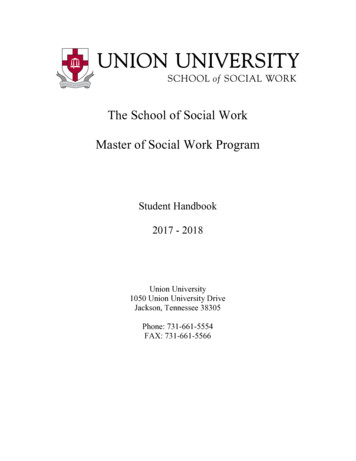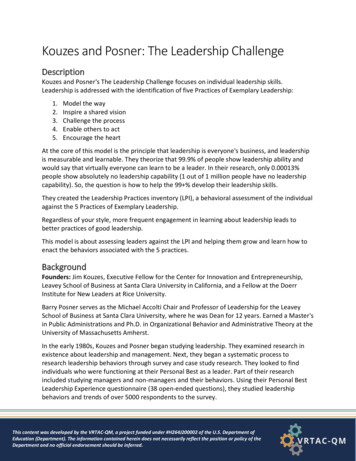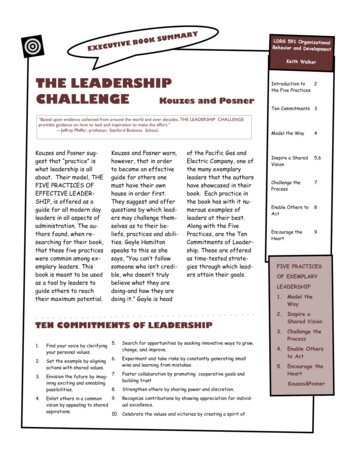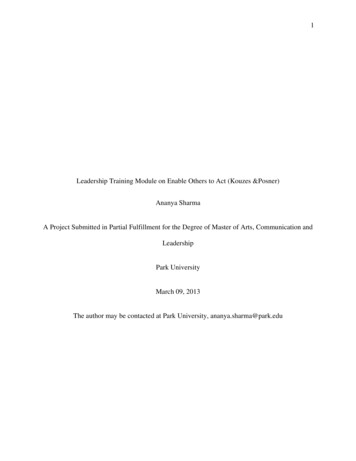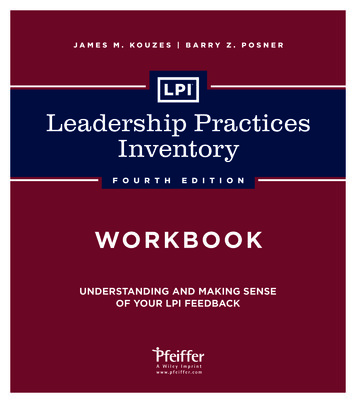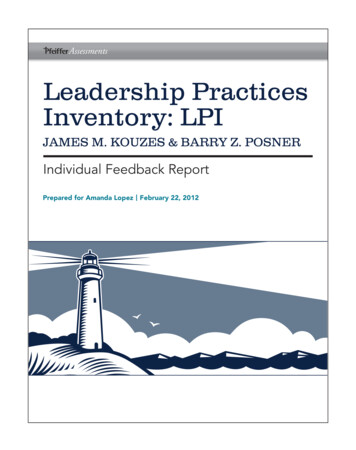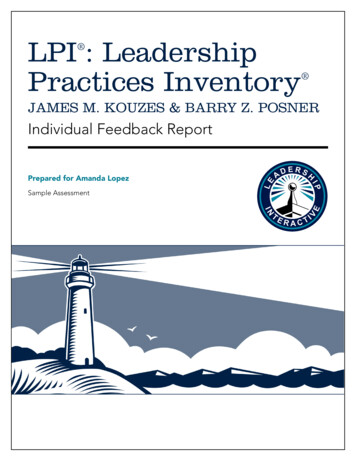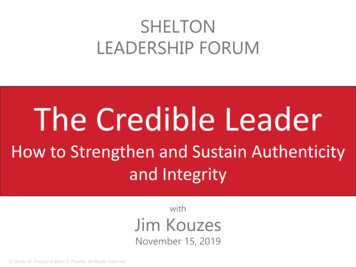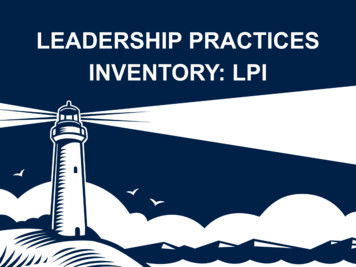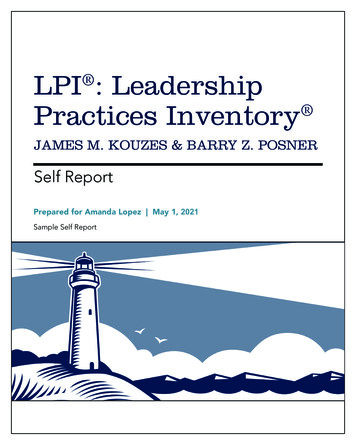
Transcription
LPI : Leadership Practices InventoryJAMES M. KOUZES & BARRY Z. POSNERSelf ReportPrepared for Amanda Lopez May 1, 2021Sample Self Report
CONTENTSThe Five Practices of Exemplary Leadership 1The Five Practices Bar Graphs2Leadership Behaviors Ranking3Model the Way Bar Graphs4Inspire a Shared Vision Bar Graphs6Challenge the Process Bar Graphs8Enable Others to Act Bar Graphs10Encourage the Heart Bar Graphs12Percentile Ranking14Suggested Reading15
Profile for Amanda LopezSample Self ReportMay 1, 2021The Five Practices of Exemplary Leadership Created by James M. Kouzes and Barry Z. Posner in the early 1980s and first identified in their internationally best-selling book,The Leadership Challenge, The Five Practices of Exemplary Leadership approaches leadership as a measurable, learnable,and teachable set of behaviors. After conducting hundreds of interviews, reviewing thousands of case studies, and analyzingmore than two million survey questionnaires to understand those times when leaders performed at their personal best, thereemerged five practices common to making extraordinary things happen. The Five Practices are:The Leadership Practices Inventory (LPI) instrument is an essential tool to help you gain perspective into how you see yourselfas a leader and what actions you can take to improve your use of the Five Practices, which research has demonstrated, yearafter year, make for more effective leaders.ABOUT YOUR LPI REPORTThe LPI measures the frequency of 30 specific leadership behaviors on a 10-point scale, with six behavioral statements for eachof The Five Practices. You rated how frequently you engage in each of these important behaviors associated with The FivePractices. The response scale is:RESPONSE SCALE1-Almost Never2-Rarely3-Seldom4-Once in a While5-Occasionally6-Sometimes7-Fairly Often8-Usually9-Very Frequently10-Almost alwaysIn the following report pages, you’ll see your responses presented in various manners.Copyright 2017 by James M. Kouzes and Barry Z. Posner. Published by The Leadership Challenge, A Wiley Brand. All rights reserved. www.leadershipchallenge.com.SELF REPORTPAGE1
Profile for Amanda LopezSample Self ReportMay 1, 2021The Five Practices Bar GraphsThese bar graphs, one for each leadership Practice, provide a graphic representation of your total rating. Total responses canrange from 6 to 60, which represents adding up the response score (from 1—Almost Never to 10—Almost Always) for each ofthe six behavioral statements related to the Practice.Model the 0556053Inspire a Shared Vision0RATING5101545Challenge the Process0RATING5101554Enable Others to Act0RATING5101553Encourage the Heart0RATING5101539Copyright 2017 by James M. Kouzes and Barry Z. Posner. Published by The Leadership Challenge, A Wiley Brand. All rights reserved. www.leadershipchallenge.com.SELF REPORTPAGE2
Profile for Amanda LopezSample Self ReportMay 1, 2021Leadership Behaviors RankingThis page shows the ranking, from most frequent to least frequent, of all 30 leadership behaviors based on your self-rating.Horizontal lines separate the 10 most and the 10 least frequent behaviors from the middle 10. The response scale runs from1—Almost Never to 10—Almost Always.MOST FREQUENTLEADERSHIP PRACTICERATING1. I set a personal example of what I expect of othersModel102. I talk about future trends that will influence how our work gets doneInspire10Challenge1011. I follow through on the promises and commitments that I make3. I seek out challenging opportunities that test my own skills and abilitiesModel1014. I treat others with dignity and respectEnable1023. I identify measurable milestones that keep projects moving forwardChallenge1024. I give people a great deal of freedom and choice in deciding how to do their workI make certain that people adhere to the principles and standards that have been6.agreed upon8. I challenge people to try out new and innovative ways to do their workEnable10Model9Challenge9Enable910. I make it a point to let people know about my confidence in their abilities9. I actively listen to diverse points of viewEncourage912. I appeal to others to share an exciting dream of the futureInspire921. I build consensus around a common set of values for running our organizationModel928. I take initiative in anticipating and responding to changeChallenge9Enable813. I actively search for innovative ways to improve what we do4. I develop cooperative relationships among the people I work withChallenge818. I ask “What can we learn?” when things do not go as expectedChallenge819. I involve people in the decisions that directly impact their job performanceEnable826. I am clear about my philosophy of leadershipModel829. I ensure that people grow in their jobs by learning new skills and developing themselvesEnable830. I get personally involved in recognizing people and celebrating accomplishmentsEncourage8Inspire716. I ask for feedback on how my actions affect other people’s performanceModel717. I show others how their long-term interests can be realized by enlisting in a common visionInspire7Encourage622. I paint the “big picture” of what we aspire to accomplishInspire625. I tell stories of encouragement about the good work of othersEncourage627. I speak with genuine conviction about the higher meaning and purpose of our workI make sure that people are creatively recognized for their contributions to the success of15.our projects20. I publicly recognize people who exemplify commitment to shared valuesInspire6Encourage5Encourage57. I describe a compelling image of what our future could be like5. I praise people for a job well doneLEAST FREQUENTRESPONSE SCALE1-Almost Never2-Rarely3-Seldom4-Once in a While5-Occasionally6-Sometimes7-Fairly Often8-Usually9-Very Frequently10-Almost alwaysCopyright 2017 by James M. Kouzes and Barry Z. Posner. Published by The Leadership Challenge, A Wiley Brand. All rights reserved. www.leadershipchallenge.com.SELF REPORTPAGE3
Profile for Amanda LopezSample Self ReportMay 1, 2021Model the Way Bar Graphs Clarify values by finding your voice and affirming shared values Set the example by aligning actions with shared valuesThe set of bar graphs for each of the six leadership behaviors related to this Practice provides a graphic representation of yourresponses for that behavior. Responses can range from 1–Almost Never to 10–Almost Always.1.6.Sets a personal exampleof what he/she expects ofothersMakes certain that peopleadhere to the principles andstandards that have beenagreed upon11. Follows through onpromises and commitmentshe/she makes16. Asks for feedback on howhis/her actions affect otherpeople’s performance21. Builds consensus arounda common set of values forrunning our organization26. Is clear about his/herphilosophy of leadershipRESPONSE most ce in a While5-Occasionally6-Sometimes7-Fairly Often8-Usually9-Very Frequently10-Almost alwaysCopyright 2017 by James M. Kouzes and Barry Z. Posner. Published by The Leadership Challenge, A Wiley Brand. All rights reserved. www.leadershipchallenge.com.SELF REPORTPAGE4
Profile for Amanda LopezSample Self ReportMay 1, 2021Reflections:?What is your immediate reaction to viewing your Model the Wayratings? Why?Please describe anything in your Model the Way ratings that isconfusing or contradictory:(Remember to review your Leadership Behaviors Ranking page to consider the individual behaviors that relate to this practice.)Suggestions for Becoming a Better Leader1. At the end of every day, ask yourself, “What have I done today that demonstrated one of my key values? What have idone today that might have sent the signal that I wasn’t committed to the key value? What can i do tomorrow to live out akey value?2. Answer the question, “What are the values that should guide my decisions and actions?”3. Do something dramatic to demonstrate your commitment to a team value. For instance, if customer service is a value,spend a day answering the phones in the call center, working behind the counter at a store, or visiting customers at theirlocations.Copyright 2017 by James M. Kouzes and Barry Z. Posner. Published by The Leadership Challenge, A Wiley Brand. All rights reserved. www.leadershipchallenge.com.SELF REPORTPAGE5
Profile for Amanda LopezSample Self ReportMay 1, 2021Inspire a Shared Vision Bar Graphs Envision the future by imagining exciting and ennobling possibilities Enlist others in a common vision by appealing to shared aspirationsThe set of bar graphs for each of the six leadership behaviors related to this Practice provides a graphic representation of yourresponses for that behavior. Responses can range from 1–Almost Never to 10–Almost Always.2.7.Talks about future trendsthat will influence how ourwork gets doneDescribes a compellingimage of what our futurecould be like12. Appeals to others to sharean exciting dream of thefuture17. Shows others how theirlong-term interests can berealized by enlisting in acommon vision22. Paints the “big picture”of what we aspire toaccomplish27. Speaks with genuineconviction about the highermeaning and purpose of ourworkRESPONSE ost ce in a While5-Occasionally6-Sometimes7-Fairly Often8-Usually9-Very Frequently10-Almost alwaysCopyright 2017 by James M. Kouzes and Barry Z. Posner. Published by The Leadership Challenge, A Wiley Brand. All rights reserved. www.leadershipchallenge.com.SELF REPORTPAGE6
Profile for Amanda LopezSample Self ReportMay 1, 2021Reflections:?What is your immediate reaction to viewing your Inspire a Shared Visionratings? Why?Please describe anything in your Inspire a Shared Vision ratings that isconfusing or contradictory:(Remember to review your Leadership Behaviors Ranking page to consider the individual behaviors that relate to this practice.)Suggestions for Becoming a Better Leader1. Become a Futurist. Join the World Futures Society. Read American Demographics or other magazines about future trends.Use the Internet to find a “futures” conference that you can attend. Make a list of what reputable people are predicting willhappen in the next ten years.2. Every week interview one of your constituents—a direct report, peer, manager, or customer—and ask, “What are youraspirations for the future?”3. Be positive, upbeat and energetic when talking about the future of your team and organization.Copyright 2017 by James M. Kouzes and Barry Z. Posner. Published by The Leadership Challenge, A Wiley Brand. All rights reserved. www.leadershipchallenge.com.SELF REPORTPAGE7
Profile for Amanda LopezSample Self ReportMay 1, 2021Challenge the Process Bar Graphs Search for opportunities by seizing the initiative and by looking outward for innovativeways to improve Experiment and take risks by consistently generating small wins and learning fromexperienceThe set of bar graphs for each of the six leadership behaviors related to this Practice provides a graphic representation of yourresponses for that behavior. Responses can range from 1–Almost Never to 10–Almost Always.3.8.Seeks out challengingopportunities that test his/her own skills and abilitiesChallenges people to try outnew and innovative ways todo their work13. Actively searches forinnovative ways to improvewhat we do18. Asks “What can we learn?”when things don’t go asexpected23. Identifies measurablemilestones that keepprojects moving forward28. Takes initiative inanticipating and respondingto changeRESPONSE SCALERATINGRATINGRATINGRATINGRATINGRATING1-Almost m4-Once in a While5-Occasionally6-Sometimes7-Fairly Often8-Usually9-Very Frequently10-Almost alwaysCopyright 2017 by James M. Kouzes and Barry Z. Posner. Published by The Leadership Challenge, A Wiley Brand. All rights reserved. www.leadershipchallenge.com.SELF REPORTPAGE8
Profile for Amanda LopezSample Self ReportMay 1, 2021Reflections:?What is your immediate reaction to viewing your Challenge the Processratings? Why?Please describe anything in your Challenge the Process ratings that isconfusing or contradictory:(Remember to review your Leadership Behaviors Ranking page to consider the individual behaviors that relate to this practice.)Suggestions for Becoming a Better Leader1. At least once a month, set aside time to think about what challenging opportunities-new experiences, job assignments,tasks- you could seek to test your skills and abilities. Look for opportunities for tough assignments.2. At least once a month, identify something you can do to challenge the way things are done—the status quo—at work. Forexample, think about what product or process innovations would help your organization improve. Then take the initiativeto make change happen.3. Once a week at a regular meeting, ask each team member to answer this question: “What have you done in the last weekto improve so that you are better this week than you were a week ago?”Copyright 2017 by James M. Kouzes and Barry Z. Posner. Published by The Leadership Challenge, A Wiley Brand. All rights reserved. www.leadershipchallenge.com.SELF REPORTPAGE9
Profile for Amanda LopezSample Self ReportMay 1, 2021Enable Others to Act Bar Graphs Foster collaboration by building trust and facilitating relationships Strengthen others by increasing self-determination and developing competenceThe set of bar graphs for each of the six leadership behaviors related to this Practice provides a graphic representation of yourresponses for that behavior. Responses can range from 1–Almost Never to 10–Almost Always.4.9.Develops cooperativerelationships among thepeople he/she works withActively listens to diversepoints of view14. Treats others with dignityand respect19. Involves people in thedecisions that directlyimpact their jobperformanceRATINGRATINGRATING24. Gives people a great dealof freedom and choice indeciding how to do theirwork29. Ensures that people growin their jobs by learningnew skills and developingthemselvesRESPONSE SCALERATINGRATINGRATING1-Almost m4-Once in a While5-Occasionally6-Sometimes7-Fairly Often8-Usually9-Very Frequently10-Almost alwaysCopyright 2017 by James M. Kouzes and Barry Z. Posner. Published by The Leadership Challenge, A Wiley Brand. All rights reserved. www.leadershipchallenge.com.SELF REPORTPAGE10
Profile for Amanda LopezSample Self ReportMay 1, 2021Reflections:?What is your immediate reaction to viewing your Enable Others to Actratings? Why?Please describe anything in your Enable Others to Act ratings that isconfusing or contradictory:(Remember to review your Leadership Behaviors Ranking page to consider the individual behaviors that relate to this practice.)Suggestions for Becoming a Better Leader1. Think about the ways in which projects are planned and decisions made in your organization. Then come up with severalactions you can take to involve others in the planning and decision-making process.2. Before every interaction, regardless of length, ask yourself this question: “What can I do in this interaction to make thisperson (or persons) feel more capable and powerful?”3. Talk one-on-one with your team members to find out what kind of support and coaching they would like from you andwhat training opportunities they need. Find ways to connect people to the resources they need—other people, materials,funding, training, information, and so on.Copyright 2017 by James M. Kouzes and Barry Z. Posner. Published by The Leadership Challenge, A Wiley Brand. All rights reserved. www.leadershipchallenge.com.SELF REPORTPAGE11
Profile for Amanda LopezSample Self ReportMay 1, 2021Encourage the Heart Bar Graphs Recognize contributions by showing appreciation for individual excellence Celebrate the values and victories by creating a spirit of communityThe set of bar graphs for each of the six leadership behaviors related to this Practice provides a graphic representation of yourresponses for that behavior. Responses can range from 1–Almost Never to 10–Almost Always.5.Praises people for a job welldone10. Makes it a point to letpeople know about his/herconfidence in their abilities15. Makes sure that people arecreatively recognized fortheir contributions to thesuccess of our projects20. Publicly recognizes peoplewho exemplify commitmentto shared values25. Tells stories ofencouragement about thegood work of others30. Gets personallyinvolved in recognizingpeople and celebratingaccomplishmentsRESPONSE SCALERATINGRATINGRATINGRATINGRATINGRATING1-Almost -Once in a While5-Occasionally6-Sometimes7-Fairly Often8-Usually9-Very Frequently10-Almost alwaysCopyright 2017 by James M. Kouzes and Barry Z. Posner. Published by The Leadership Challenge, A Wiley Brand. All rights reserved. www.leadershipchallenge.com.SELF REPORTPAGE12
Profile for Amanda LopezSample Self ReportMay 1, 2021Reflections:?What is your immediate reaction to viewing your Encourage the Heartratings? Why?Please describe anything in your Encourage the Heart ratings that isconfusing or contradictory:(Remember to review your Leadership Behaviors Ranking page to consider the individual behaviors that relate to this practice.)Suggestions for Becoming a Better Leader1. Think of ten small ways in which you can reward people who have done something especially well. Then reward thoseextraordinary efforts. Don’t let them go by unnoticed.2. Identify those constituents who best embody your values and priorities and think of three ways to single them out in theweeks to come, to praise and reward them.3. Tell a public story about a person in your organization who went above and beyond the call of duty.Copyright 2017 by James M. Kouzes and Barry Z. Posner. Published by The Leadership Challenge, A Wiley Brand. All rights reserved. www.leadershipchallenge.com.SELF REPORTPAGE13
Profile for Amanda LopezSample Self ReportMay 1, 2021Percentile RankingThe leaders and observers who make up the LPI database include a mix of males and females at all levels, from all types oforganizations, and from all over the world. This page compares your responses to all Observer responses for other leaderswho have taken the LPI. The horizontal lines at the 30th and 70th percentiles divide the graph into three segments, roughlyapproximating a normal distribution of scores. Each line on the graph shows what percentile your response falls into for eachPractice. For example, if your score for Model the Way is at the 50th percentile, half of the leaders in the entire LPI databasewere rated higher (by their Observers who also rated them on the Practice), and half were rated lower.MOST FREQUENT100MODELTHE WAYINSPIRE ASHARED VISIONCHALLENGETHE PROCESSENABLEOTHERS TO ACTENCOURAGETHE HEART908070FREQUENT605040LEAST FREQUENT3020100Copyright 2017 by James M. Kouzes and Barry Z. Posner. Published by The Leadership Challenge, A Wiley Brand. All rights reserved. www.leadershipchallenge.com.SELF REPORTPAGE14
Profile for Amanda LopezSample Self ReportMay 1, 2021Suggested ReadingGENERAL LEADERSHIPKouzes, J. M., and Posner, B. Z. A Leader’s Legacy. San Francisco: Jossey-Bass, 2006.Kouzes, J. M., and Posner, B. Z. The Leadership Challenge: How to Make Extraordinary Things Happen in Organizations. 5th Edition.San Francisco: Jossey-Bass, 2012.Kouzes, J. M., and Posner, B. Z. The Truth About Leadership: The No-Fads, Heart-of-the-Matter Facts You Need to Know. SanFrancisco: Jossey-Bass, 2010.MODEL THE WAYConant, D., and Norgaard, M. TouchPoints: Creating Powerful Leadership Connections in the Smallest of Moment. SanFrancisco:Jossey-Bass, 2011Kouzes, J. M., and B. Z. Posner. Credibility: How Leaders Gain and Lose It, Why People Demand It. (2nd ed.). San Francisco: Jossey-Bass, 2011.Kraemer, H. M. J., Jr. From Values to Action: The Four Principles of Values-Based Leadership. San Francisco: Jossey-Bass, 2011.Rhoads, A., with Shepherdson, N. Built on Values: Creating an Enviable Culture That Outperforms the Competition. San Francisco:Jossey-Bass, 2011.Schein, E. Organizational Culture and Leadership. (4th ed.). San Francisco: Jossey-Bass, 2010.INSPIRE A SHARED VISIONGeary, J. I Is an Other: The Secret Life of Metaphor and How It Shapes the Way We See the World. New York: Harper, 2011.Schuster, J. P. The Power of Your Past: The Art of Recalling, Recasting, and Reclaiming. San Francisco: Berrett-Koehler, 2011.Sinek, S. Start with Why: How Great Leaders Inspire Everyone to Take Action. New York: Portfolio, 2010.Spence, R. M. It’s Not What You Sell, It’s What You Stand For: Why Every Extraordinary Business Is Driven by Purpose. New York:Portfolio, 2010.Sullenberger, C. B. Making a Difference: Stories of Vision and Courage from America’s Leaders. New York: William Morrow, 2012.Ulrich, D., and Ulrich, W. The Why of Work: How Great Leaders Build Abundant Organizations That Win. New York: McGraw-Hill, 2010.CHALLENGE THE PROCESSAmabile, T. A., and Kramer, S. J. The Progress Principle: Using Small Wins to Ignite Joy, Engagement, and Creativity at Work. Boston:Harvard Business Review Press, 2011.Johnson, S. Where Good Ideas Come From: The Natural History of Innovation. New York: Riverhead, 2010.Seligman, M.E.P. Flourish: A Visionary New Understanding of Happiness and Well-Being. New York: The Free Press, 2011.Sims, P. Little Bets: How Breakthrough Ideas Emerge from Small Discoveries. New York: The Free Press, 2011.ENABLE OTHERS TO ACTBrooks, D. The Social Animal: Hidden Sources of Love, Character, and Achievement. New York: Random House, 2011.Burchell, M., and Robin, J. The Great Workplace: How to Build It, How to Keep It, and Why It Matters. San Francisco: JosseyBass, 2011.Hurley, R. F. The Decision to Trust: How Leaders Create High-Trust Organizations. San Francisco: Jossey-Bass, 2012.Merchant, N. The New How: Creating Business Solutions Through Collaborative Strategy. San Francisco: O’Reilly Media, 2010.Shockley-Zalabak, P. S., Morreale, S. and Hackman, M. Building the High-Trust Organization: Strategies for Supporting Five KeyDimensions of Trust. San Francisco: Jossey-Bass, 2010.Wiseman, L. Multipliers: How the Best Leaders Make Everyone Smarter. New York: HarperCollins, 2010.ENCOURAGE THE HEARTAchor, S. The Happiness Advantage: The Seven Principles of Positive Psychology That Fuel Success and Performance at Work. NewYork: Crown Books, 2010.Gostick, A., and Elton, C. All In: How the Best Managers Create a Culture of Belief and Drive Big Results. New York: The Free Press, 2012.Kouzes, J. M., and Posner, B. Z. Encouraging the Heart: A Leader’s Guide to Rewarding and Recognizing Others. San Francisco:Jossey-Bass, 2003.Rath, T., and Harter, J. Well-Being: The Five Essential Elements. New York: Gallup Press, 2010.Seligman, M. E. Flourish: A Visionary New Understanding of Happiness and Well-Being. New York: The Free Press, 2011.Copyright 2017 by James M. Kouzes and Barry Z. Posner. Published by The Leadership Challenge, A Wiley Brand. All rights reserved. www.leadershipchallenge.com.SELF REPORTPAGE15
The Five Practices of Exemplary Leadership Created by James M. Kouzes and Barry Z. Posner in the early 1980s and fi rst identifi ed in their internationally best-selling book, The Leadership Challenge, The Five Practices of Exemplary Leadership approaches leadership as

